Saturn 2024 Apparition Notes

Return to the Saturn, Uranus and Neptune Section home page
2024 March
The first observation of this apparition was made by Trevor Barry (408mm Newtonian) on Mar 20 from Australia using an IR filter (>685nm) filter. This observation was made under difficult conditions (planet at a very low altitude and the sun just coming over the horizon). However the NEB was revealed plus a bright Equatorial Zone. The low inclination of the rings with respect to the Earth (~ 4.8 degrees) was also shown. A similar observation was made on Mar 27 when the Cassini Division was just resolved in each ansae.
2024 April
Observations were made by Trevor Barry on April 9, 15 and 22 and by Andy Casely (C14) from Australia on April 11.
Trevor’s images were again made with the IR (>685 nm filter) plus a methane band (889nm) filter on April 15. Andy’s images were made with a R filter and RGB.
The NEB was the most prominent belt with another darker belt at mid temperate latitudes. A fainter SEB was also visible. Both NEB and SEB were visible in the methane image. The EZ was bright with a band in the northern EZ. The ring shadow was projected just south of where the rings crossed the disk.The Cassini Division was visible in both ansae in the RGB image.
Trevor’s images taken on April 15, revealed a spot at a latitude of approximately -55 degrees. A similar object was observed during the previous apparition.
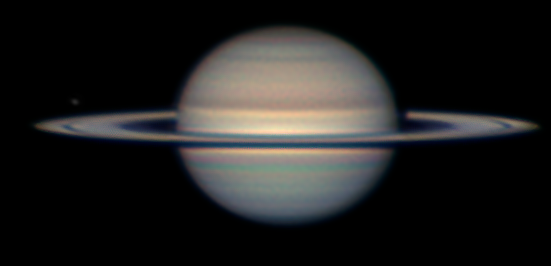
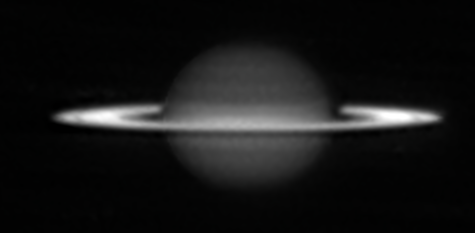
2024 May
During this month, observations were made by Trevor Barry on May 12, 25 and 25, and Andy Casely on May 21.
Trevor used IR (>685nm), methane (889nm) and RGB filters whereas Andy used RGB and IR (>685 filters).
The narrow rings are shown with the Cassini Division just resolved at the extremities of each ring. The ring shadow onto the globe was projected onto the southern EZ. Both major belts (i.e. the NEB and SEB) were easily visible; with the NEB showing a warmer tone than the SEB. An EB was visible in the northern EZ.
Some belt and zone detail was resolved in the methane images and the rings also appeared bright.
On May 12, Trevor recorded a transit of Tethys and its shadow; with the shadow easier to detect.
The long lived Anti Cyclonic Vortex (AV) originated in the Great Storm of 2010/2011 and was still visible during the last apparition. On May 25, this was detected again by Trevor and subsequently on May 26 in IR images.
Trevor also detected a light oval on May 25 at high southern latitudes. This may be identical to a similar oval detected during the last apparition.
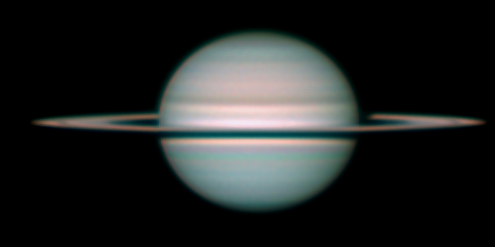
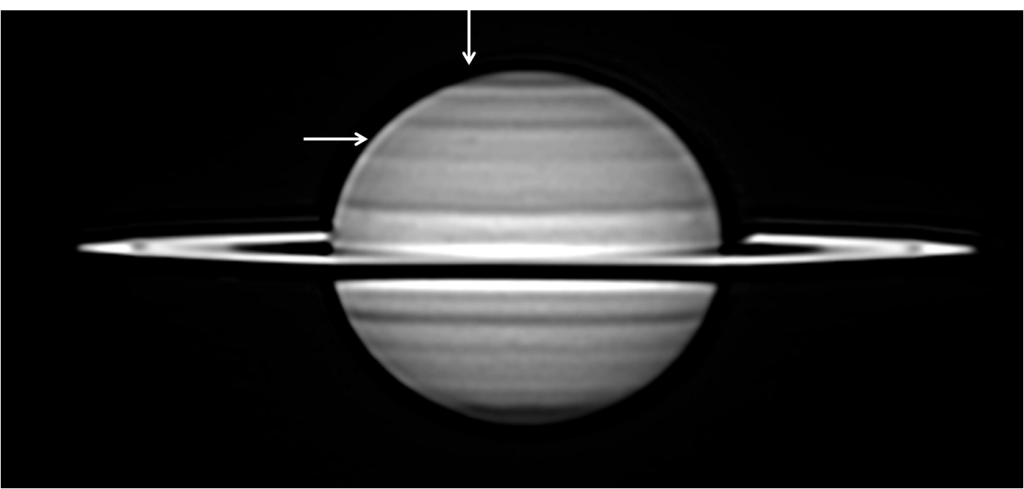
2024 June
This month, observations have been received from Trevor Barry on June 6, 1, 22 and 26, Andy Casely on June 23, Mike Hood (USA) with Stephen Ehrhart, June 9, Chris Dole (UK) June 23, Efrain Morales (Puerto Rico) on June 18, Luigi Morrone (Italy) on June 6, 18 and 29, Peter Tickner (UK) June 2, 6 , 9, 25 and 29, Jim Tomney (USA) on June and 21.
The NEB is still the darkest belt with a warm colour. Other areas of the planet appear colder in tome with a bluish or grey hue. The shadow of the rings onto the planet is projected onto the southern EZ. Ring detail such as the Cassini Division is difficult to resolve due to the low inclination of the rings.
On June 6, 22 and 26, Trevor again recorded the AV and a large amount of fine detail on June 22. On June 2, Trevor also recorded a transit of Dione and its shadow.
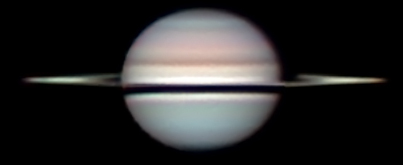
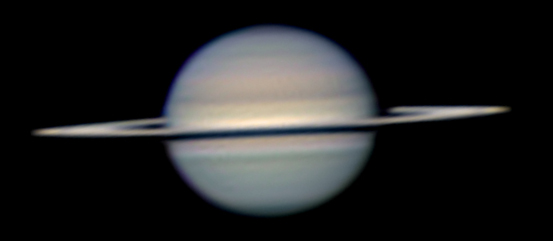
2024 July
This month, observations have been received from Trevor Barry on July 4, 9 12, 20,28 and 29, David Basey (UK) on July 28, Michael Buechner (Germany) July 21, Mikde Foulkes July 31, Massimo Giuntoli on July 13, David Graham on July 28, Mike Hood July 12, Efrain Morales on July 23, 28 and 31, Luigi Morrone on July 16 and 19, Dean Norris (USA) on July 16, Mattia Piccoli (Italy) July 16 and 29, Gregory T Shanos (USA) July 16 . Peter Tickner (UK) on July 14, 15, 20, 22 and 30, Gary Walker on July 16, and Johan Warell (Sweden) on July 19, 29, 21 and 23, Anthony Wesley (Australia) on July 8, 11, 20 28, and 29.
The AV was imaged Trevor on July 4, 1, 20 24 and 29, and by Anthony on July 8.
Transits of some satellites have been observed ,Trevor captured a transit of Dione and its shadow on July 4. and Anthony captured a transit of Dione on 20. Luigi imaged a shadow transit of Rhea on July 16. (See below). Although Rhea itself was in transit at the same time, it was not detected. However Tethys was detected in transit. Here it was projected against the ring shadow onto the globe (p. side). He also recorded Titan’s disk.
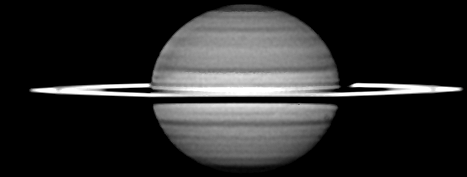
AV visible at mid temp. latitudes on disk centre.
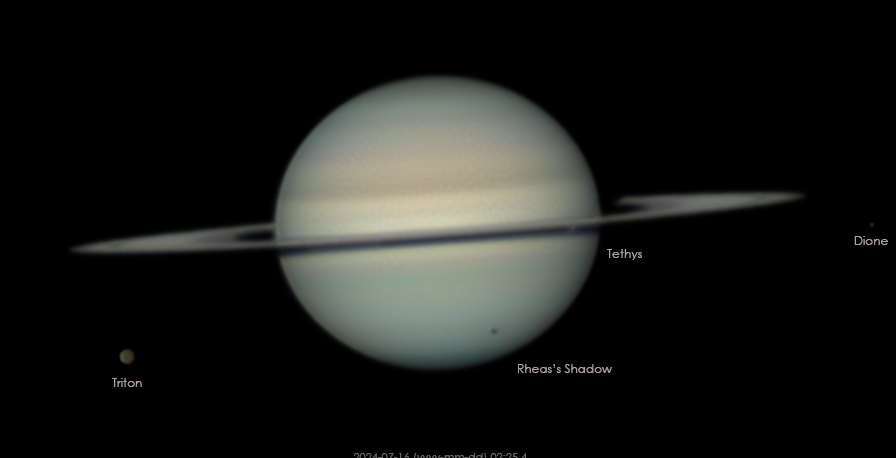
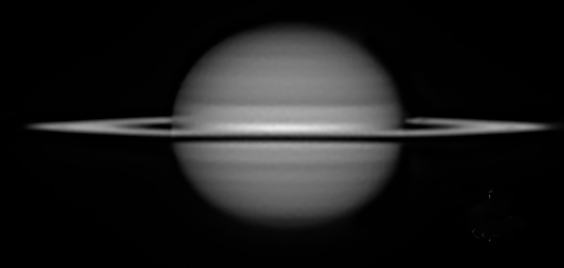
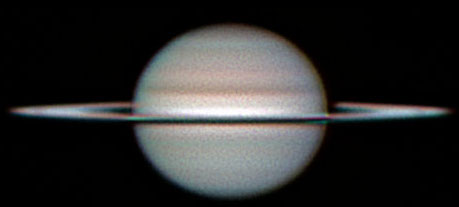
A series of Titan phenomena are occurring this year and predictions are shown via the section home page. Dean, gary and Gregory were able to observe the transit of Titan on July 16as shown below. Gregory’s series of images (not all shown here) show the change in the appearance of Titan from a bright object to a dark object when in ingress and the reverse during egress.
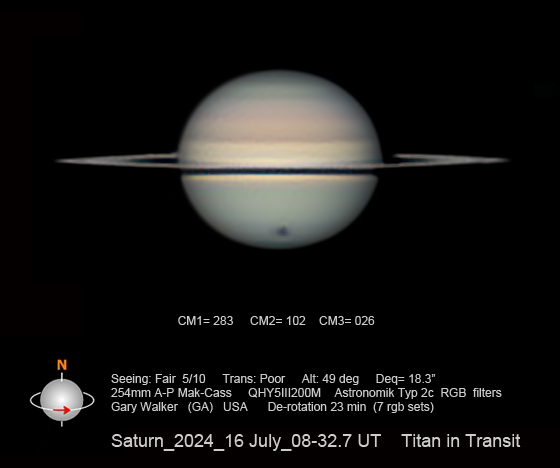
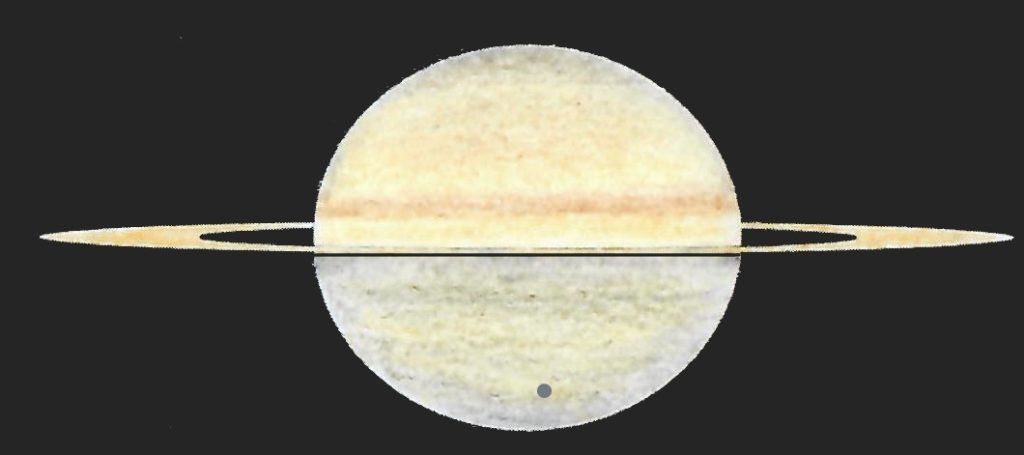
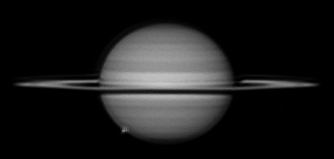
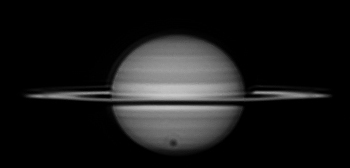
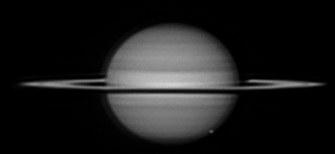
On July 20 and 28, Trevor Reported some bright features on the northern boundary of the SPR. On July 29, in excellent seeing he also reported a bright oval at a latitude of -55 to -56 degrees latitude. He also recorded a double transit of Dione plus Rhea and its shadow (see below).
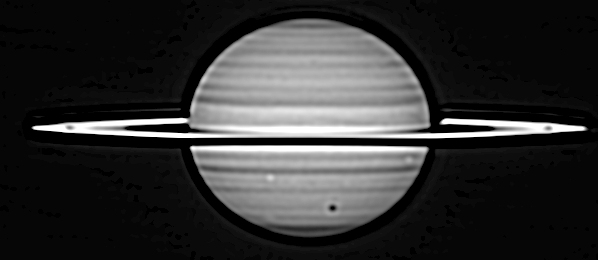
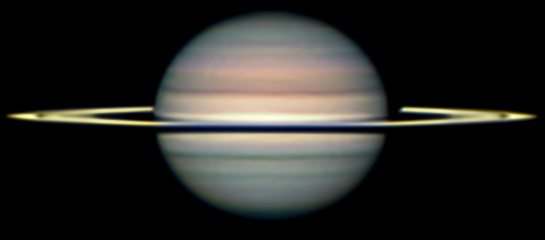
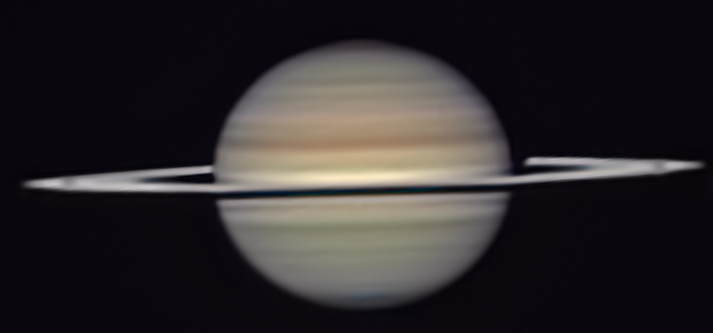
August 2024
This month observations have been received from: Paul Abel on August 24, Trevor Barry on August 10, 14, 19 and 26,David Basey on August 7, 13 and 17, Andy Casely on August , James Dawson on August 11 and 30, Mike Foulkes on August 7, 13 and 29, David Graham on Aug 28 an 30, Alun Halsey on August 28, Mike Hood on August 3 and 10, Bill Leatherbarrow on August 7 and 11, Raffaello Lena (Italy) on August 2, 4, 7, 11 and 29, Peter Milligan on August 28, Efrain Morales on Aug 4, 22 and 28, Luigi Moronne on August 15, 22 and 24, Peter Mulligan on August 28. Mattia Piccoli on August 1, Richard Severn on August 30, Gregory T. Shanos on August 1, Peter Tickner on August 5, 7, 10, 16 and 29, Jim Tomney on August 1, Johan Warell on August 1 and 3 and Anthony Wesley on August 8 14, 16, 18, 19, 20, 21 and 22.
Numerous belt components have been detected in many images. The two darkest belts (one in each hemisphere) are components of the NEB and SEB. Actual designations using the classical nomenclature will be given when detailed latitude measurement shave been taken. However some very preliminary latitude (planetocentric) measurements of the belt edges moving north to south are given below.
Northern Hemisphere: +52 to +48, +42 to +39, +36 to +33, +27 to +23, +27 to +24, +19 to +15 (Component of NEB, darkest belt), +8 to +5 (EB)
Southern Hemisphere: -9 to -11, -14 to -17., -21 to -25 (Component of SEB, darkest southern hemisphere belt), -35 to -38, -41 to -43.
The AV was detected by Trevor on August 14 and 26 and by Anthony on August 18 and 21 but in both cases it was very small. Indeed in a Hubble Space Telescope image taken on 2024 August 23, it appears very small. The drift chart for the AV so far during this apparition is shown below. I addition, the drift chart for the reddish spot at ~55 deg south is also shown below. This is showing a very rapid drift of approximately -3 deg/day relative to System III. The latitude and drift are very close to a similar spot seen during the previous apparition. An assessment as to whether they are identical has still to be made.
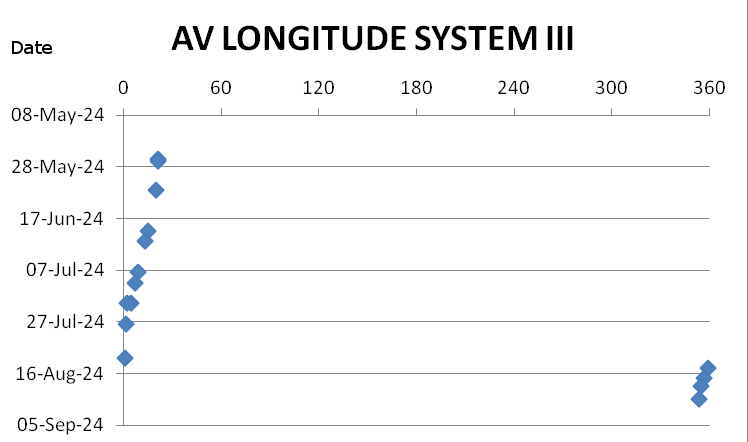
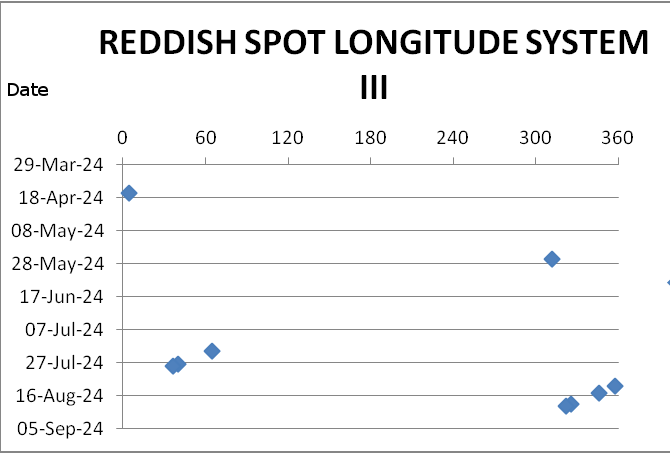
A number of satellite transits have been recorded.
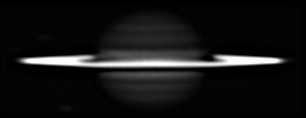
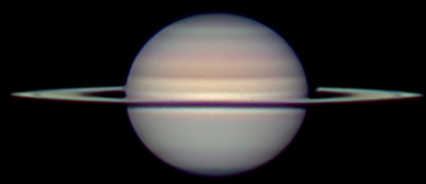
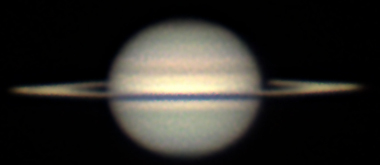
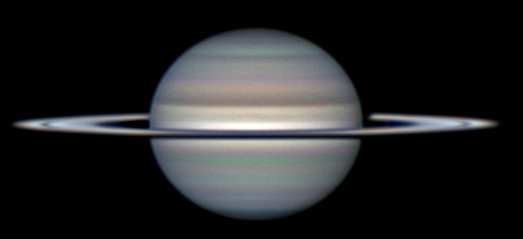
On August 01 Jim and Gregory were was able to capture Titan in transit plus the shadow of Dione (see below).
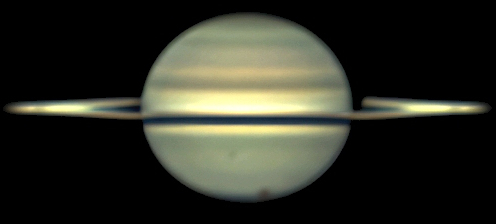
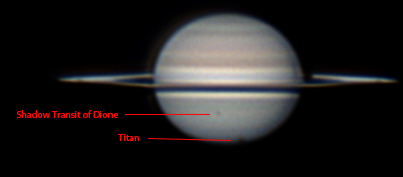
On August 7 Andy recorded a double satellite and shadow transit of Rhea and Tethys and David recorded a shadow transit of Tethys on August 17.
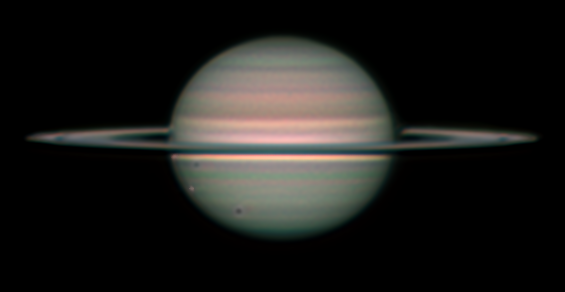
An occultation of Saturn by the Moon was predicted on August 21. An observers’ challenge for this event was put onto the main page of the BAA web site.
The following were able to observe this, i.e. Steve Brown, Emilio Colombo, James Dawson, Mike Foulkes, Steve Knight, Raffaello Lena, Martin Lewis, Richard Severn, Peter Tickner, Alexandrer Vandenbohede, Callum Wingrove,, Richard 7 (Full name TBC). Some observations of this event have been posted on the BAA web page gallery section and have been picked up in the gallery of the section’s home page. Some observers sent images directly into the Section. Some observers were able to produce animations.
2024 September
This month observations have been received from: Paul Abel on September 16, Gianluigi Adamoli on September 9, Trevor Barry on September 2, 3, 8, 12 and 15, Konstantinos Beis on September 16, Karl Schwarzkopf-Bowers on September 16, Michael Buechner on September 9, Gary Eason on September 28, Mike Foulkes on September 10, 11 16 and 27, Massimo Giuntoli on September 29, David Graham on September 17, 18 and 27, Carl Frederik Hansen on September 15, Rik Hill on September 9, Mike Hood on September8, Bill Leatherbarrow on September 17, Geof Lewis on September 14, 20 and 21, Martin Lewis on September 14, Richard McKim on September 8, Efrain Morales on September 6, 8, 10, 13 and 22, Peter Mulligan on September 14, Gregory T. Shanos on September 8 and 20, Peter Tickner on September 14, 16, 18 and 19.
Opposition was on September 8, and several observers observed the Seeliger effect. The ring inclination to the Earth increased during this month but decreased relative to the sun. As a result, post opposition the rings appeared less bright in many images. Some finer detail was detected in some images. However the AV remained faint and was only recodred by Trevor on Sep 3, when it was preceded by a bright spot.
Rik captured satellite Enceladus as shown below.
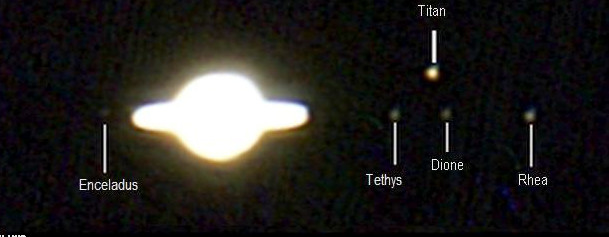
Several observers recorded satellite transits (see below).
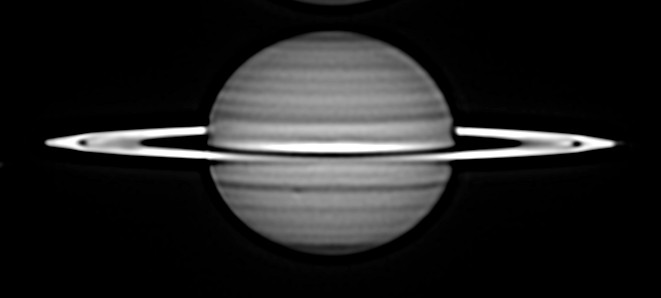
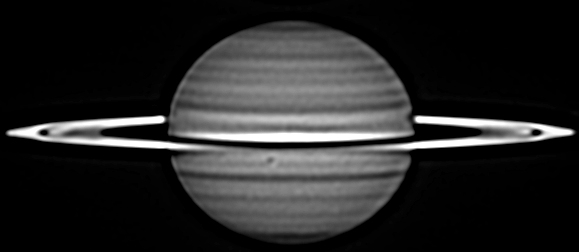
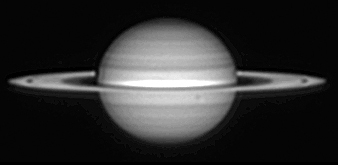
2024 October
This month observations have been received from: Paul Abel on October 21, Gianluigi Adamoli on October 29, Trevor Barry on October 5, 9 and 29, David Basey on October 11 and 23,, Karl Schwarzkopf-Bowers on October 3, Andy Casely on October 10 and 22, Mike Foulkes on October on 3, 10, 19, 21, 22, 23 and 31, Massimo Giuntoli on October 29, David Graham on October 3, 24 and 29, Carl Frederik Hansen on October 3 and 23, Mike Hood on October 24, , Bill Leatherbarrow on October 10, Martin Lewis on October 3, 10 and 31, Richard McKim on October 3, 4 and 10, Efrain Morales on October 2, 5, 11, 12, an 17, Luigi Morrone on October 27, Manolo Rodriguez on October 1, 21 and 22, , Peter Tickner on October 3.
A comparison of the appearance of the planet with different filters is given below.
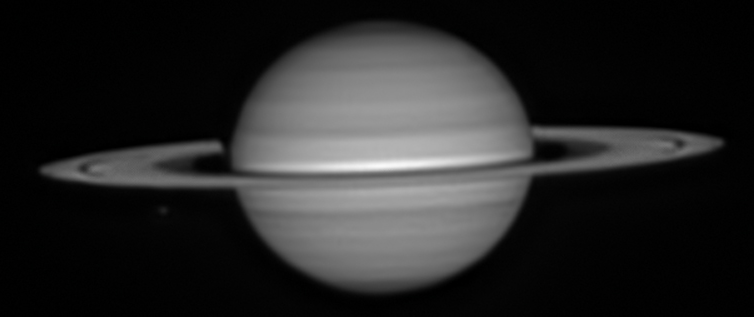
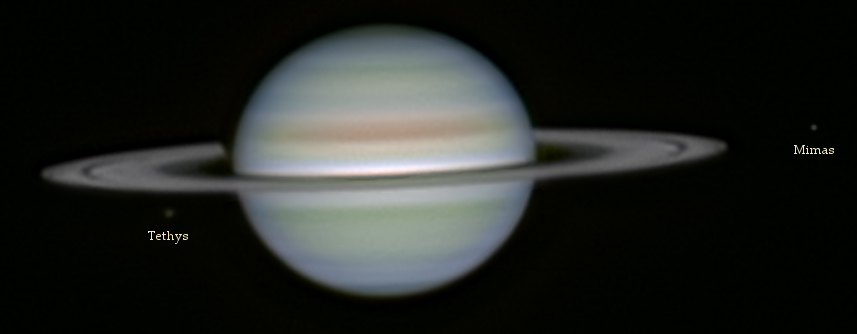
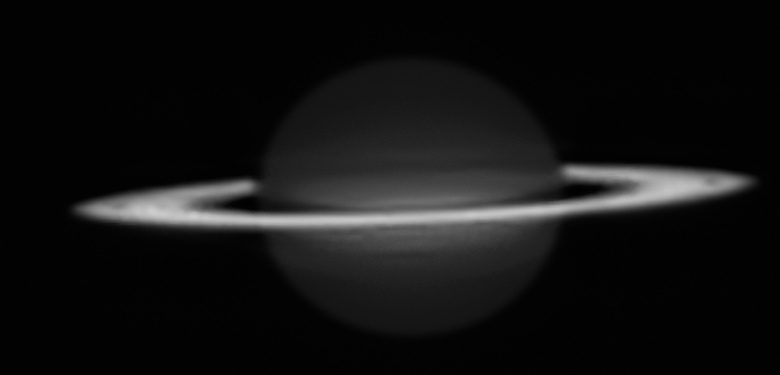
Some faint distinct features have been recorded in Andy and Trevor’s images but further work is required to see if these are long-lived. Trevor was able to detect the AV on October 5, 9 and 29 but it was very faint and difficult to detect on all of these dates.
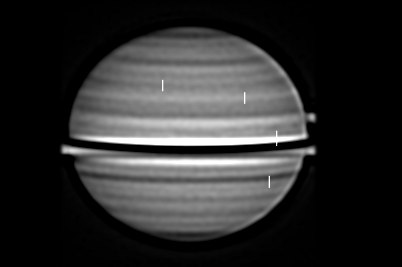
Several observers commented on the reduced brightness of the rings, as the ring inclination to the Sun decreases. The Cassini Division has become a little easier to detect with the increasing inclination of the rings to the Earth,
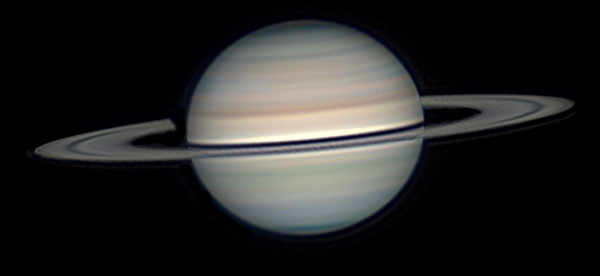
Several satellite transits were observed. Richard was able to visually observe a transit of Tethys and its shadow on October 10.

Luigi captured the shadow of Enceladus in transit on October 27, which is a rare observation. He also imaged the disk of Titan.
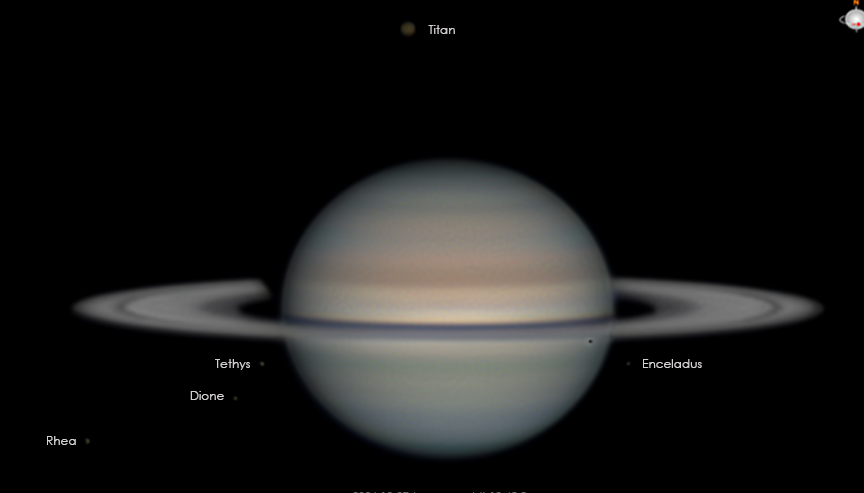
Andy imaged ring spokes on October 22.
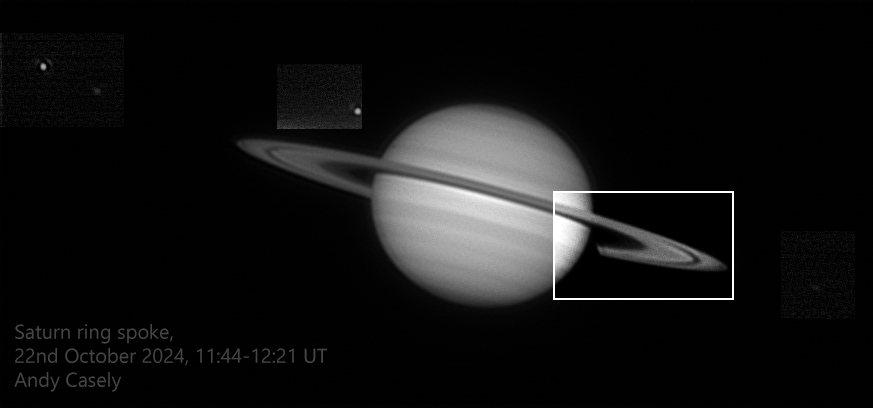
2024 November
During this month, observations have been received from: Trevor Barry on November 13, `14, 15 and 27. David Basey on November 29, Mike Foulkes on November 11, 20, 21, 27 and 28, David Graham on November 11 and 26, Alun Halsey on November 22, Rik Hill on November 20, Kevin Kell on November 3 and 7, Bill Leatherbarrow on November 26, Geof Lewis on November 20, Richard McKim on November 12, 13, 20, 26 and 29, Efrain Morales on November 2, 13, 14, 22, and 25, Luigi Moronne on November 6 and 9, Mark Radice on November 5 and 20, Gregory T. Shanos on November 27, Alan Snook on November 20, Peter Tickner on November 20, Brendan Tynan on November 26, James Weightman on November 14,
The ring inclination with respect to the Earth opened up a little more during this month but the rings appeared fainter with the reduced inclination to the Sun.
Trevor again recorded some fine detail including the AV on November 14 and 15 plus two light spots in the southern hemisphere on November 27.
Gegory Shanos observed a shadow transit of Dione on November 27 as did Richard McKim.
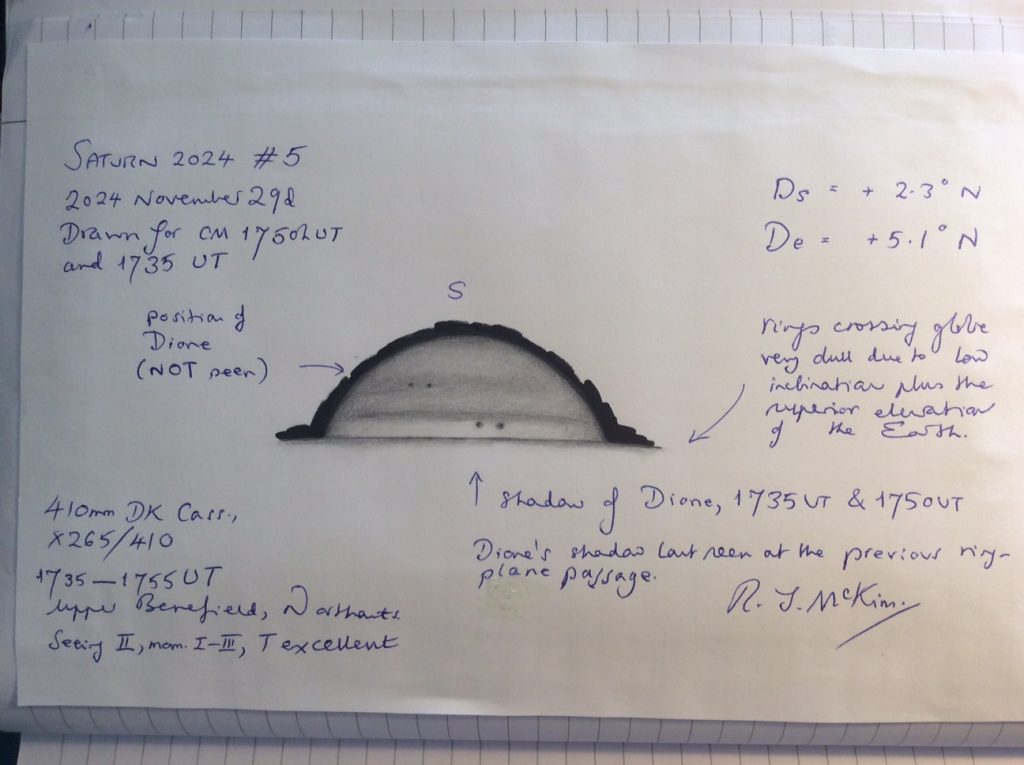
.
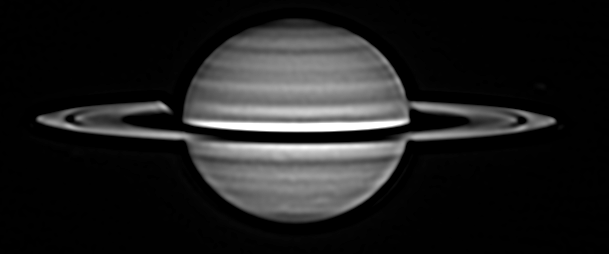
Several observers observed the Titan shadow transit on November 20, i.e. Mike Foulkes, Geof Lewis, Richard McKim, Mark Radice, Alan Snook and Peter Tickner. Observers in the UK had often poor seeing or cloud. However Mark Radice observing in Namibia had good conditions.
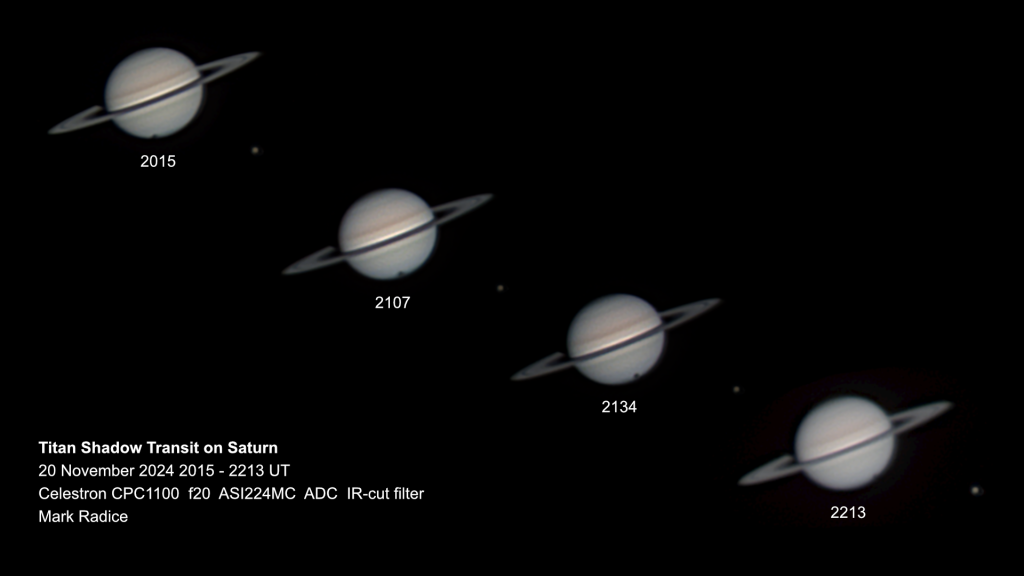
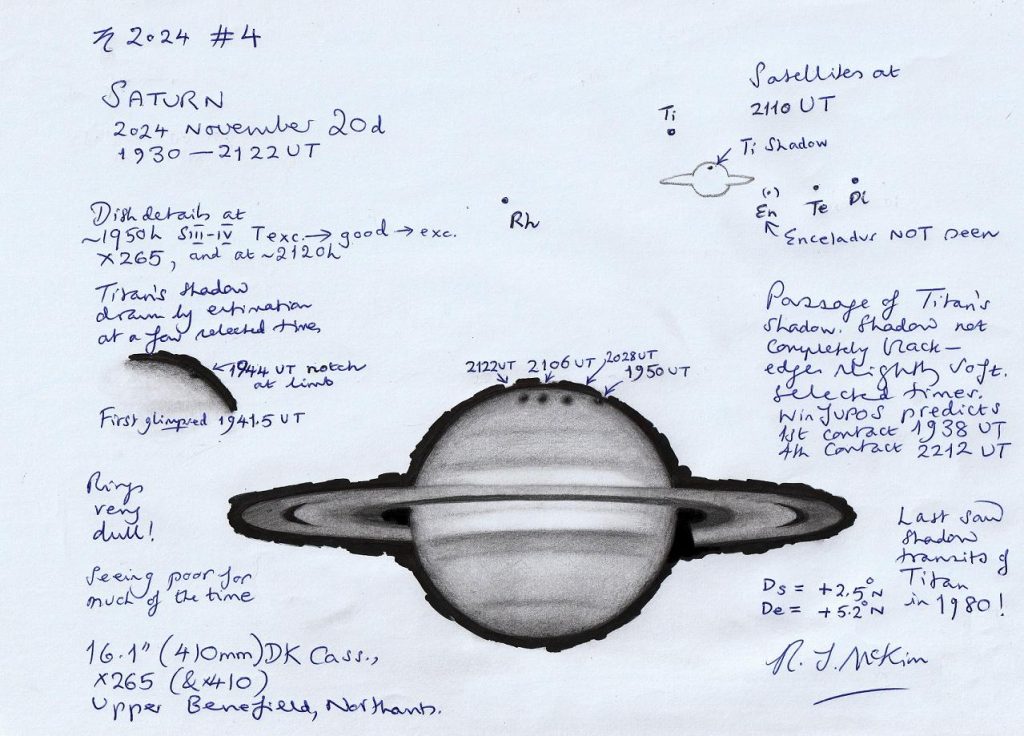
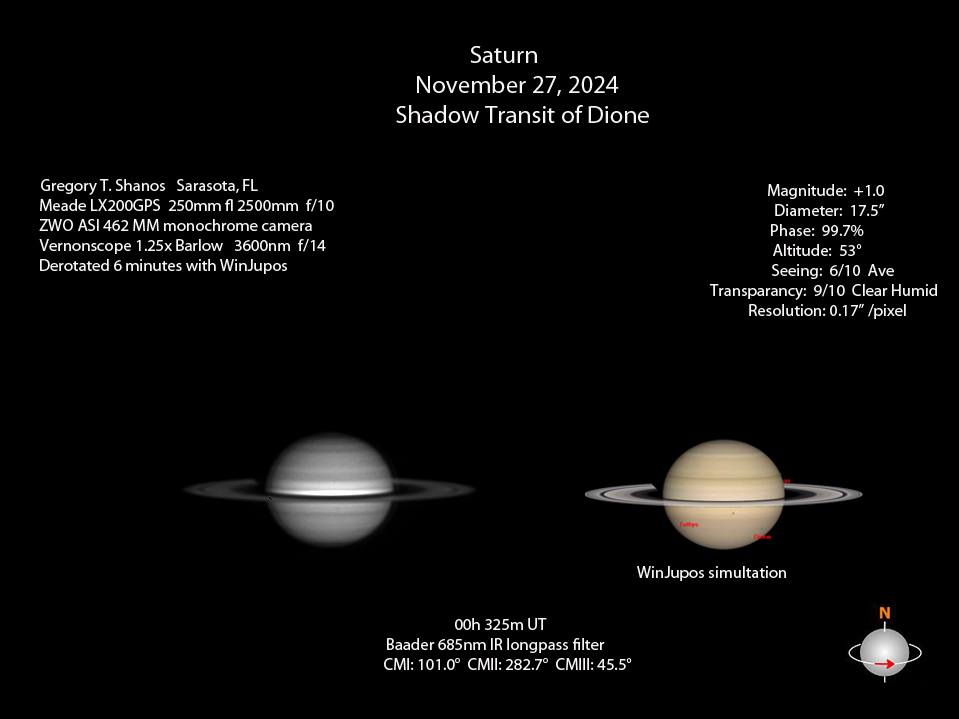

2024 December
During this month, observations have been received from: Trevor Barry on December 4, 11, 18, 24, and 25, Massimo Giuntoli on December 28, David Graham on December 26 and Frank J, Melillo on December 6.
Frank was able to observe a shadow transit of Titan on December 6 during daylight (see below).
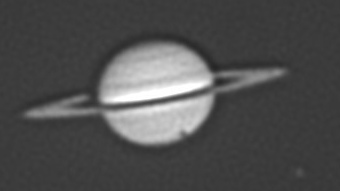
2025 January / February
During this month observations have been received from: Gianluigi Adamoli on January 11, Trevor Barry on January 1, Emileo Colombo on January 15, 17 and 29, February 2, Mike Foulkes on January 7 and Richard McKim on January 7.
Richard and Mike were able to observe Titan’s shadow transit on January 7.
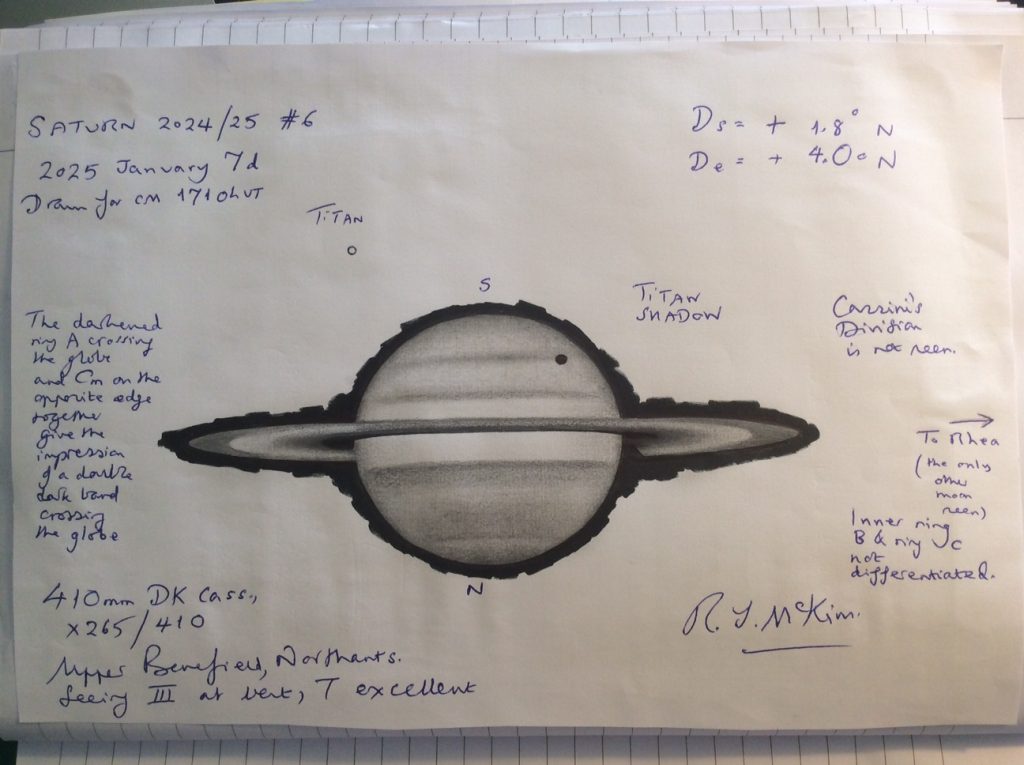
https://britastro.org/wp-content/uploads/2024/07/2024-July-16-0845-Dean-Norris-381mm-Newt.jpeg
| The British Astronomical Association supports amateur astronomers around the UK and the rest of the world. Find out more about the BAA or join us. |
